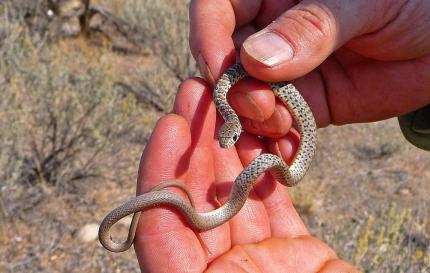This snake is one of 11 subspecies of the North American racer (simply known as “racers”).
According to NatureServe, the state conservation status of the western racer population is considered “secure” in Washington.
Description and Range
Physical description
Adult western racers can be up to 3 to 6 feet in length. They are a slender snake that have a darker topside (may be brownish, dark green, gray, or blackish) and light colored belly.

Juvenile racers have indistinct blotching, smooth scales, and no eye mask compared to gophersnakes.
The rubber boa is sometimes confused with the racer because both species have similar coloration. Racers differ in having large eyes, large dorsal scales and a tail that tapers to the tip. Racers are fast, aggressive snakes whereas rubber boas are slow, non-aggressive snakes.
Ecology and life history
Racers occur in warm, dry, open, or brushy country. They are often observed streaking across roads.
The racer holds its head and neck above the ground when hunting, and it may climb into shrubs. The diet of racers includes small mammals, reptiles, and insects.
They breed in early summer. Females lay eggs in cavities in such places as decaying logs and animal burrows. The eggs hatch in late summer.
Geographic range
The western yellow-bellied racer (Coluber constrictor Mormon) occurs in eastern Washington. Racers have been also located in southern Puget Sound.
This map from the Washington Herp Atlas illustrates the distribution of western racer in Washington based on records in the WDFW database as of 2016. If you see this species in areas that are not indicated on the map or have more recent observations (less than 10 years), please share your observation using the WDFW wildlife reporting form.
For a map of range-wide distribution and conservation status of this species, check out NatureServe Explorer.
Regulations
Licenses and permits
Be advised that collection of this species is only permitted under a WDFW Scientific Collection Permit for research and educational activities.
Living with wildlife
Snakes are among the most misunderstood of all animals. Of the dozen or so species of snakes found in Washington, only the western rattlesnake is capable of inflicting a venomous bite, which it seldom does. All snakes are an important part of the natural food chain, eating a variety of prey—from mice and birds to frogs and insects.
Observe snakes, like all wild animals, from a respectful distance. Learn more about living with snakes.
Resources
References
WDFW educational resources
- Wild Washington Lesson Plan – Herps in Washington - Elementary school students are introduced to the cold-blooded world of reptiles and amphibians, also known as herps.
- Family Education – Amphibians and Reptiles - Slither, hop, or crawl on over to learn about herpetofauna!